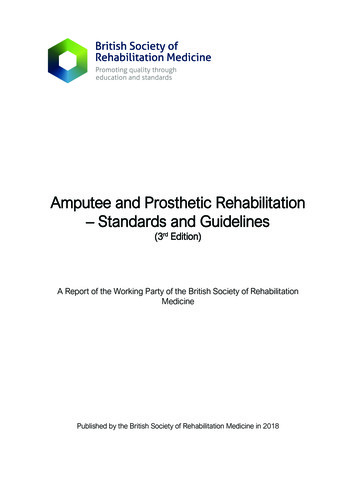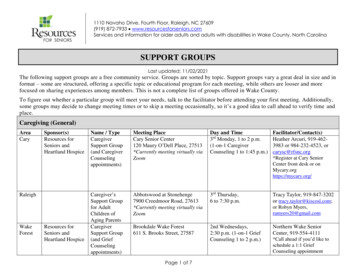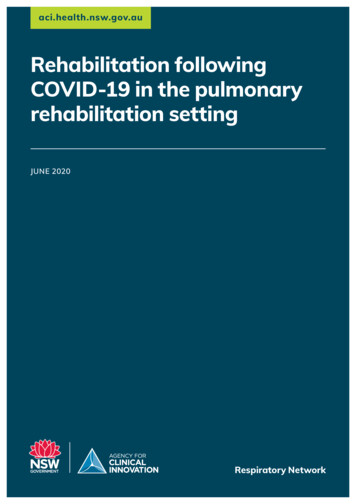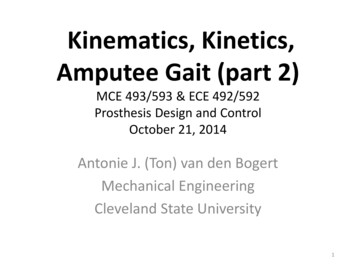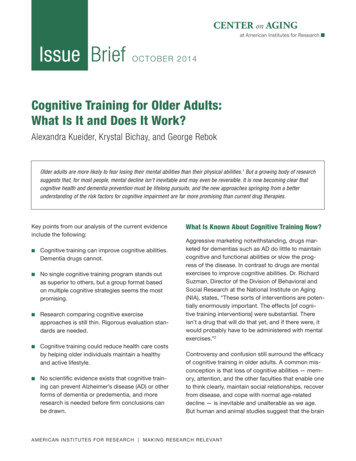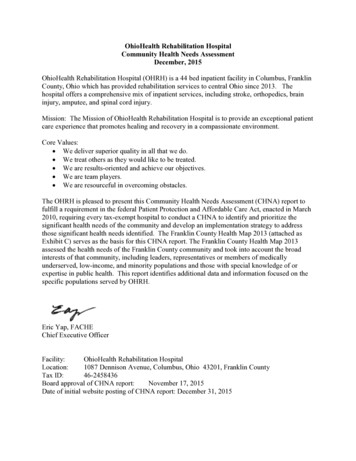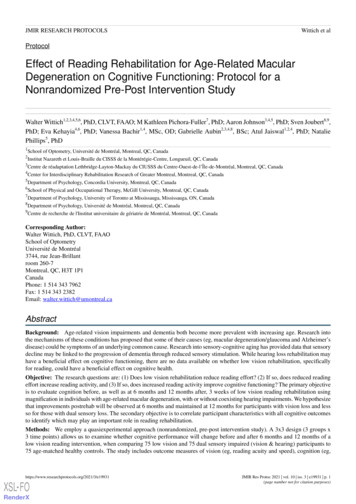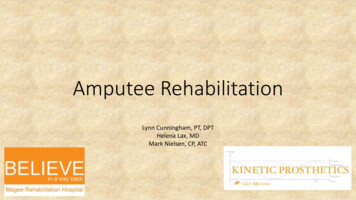
Transcription
Amputee RehabilitationLynn Cunningham, PT, DPTHelena Lax, MDMark Nielsen, CP, ATC
Objectives Participants will be able to identify common causes for upper and lowerextremity amputation and demonstrate an understanding of the medicalcomplications that require management throughout both the pre and postprosthetic phases of rehabilitation. Participants will be able to identify each phase of rehabilitation for thelower extremity amputee and list several interdisciplinary goals related toeach phase. Participants will be able to identify basic upper and lower extremityprosthetic componentry and recognize more advanced options forprosthetic componentry.
Objectives Participants will demonstrate an understanding of coding andreimbursement issues related to upper and lower extremityprosthetic prescription. Participants will be able to identify several resources available to theindividual with upper and lower extremity amputation.
Course Outline Demographics & Etiology Terminology Surgical Considerations Phases of Amputee Rehabilitation Amputee Education Current Prosthetic Management Case Study Amputee Resources
Demographics & Etiology
Demographics & EtiologyCurrently, there are an estimated 2-3 million people living with limbloss in the United StatesLower limb amputations performed annually in the USA1989: 127,000 per year1999: 185,000 per yearThe number of people living with limb loss in the USA is expected todouble by 2050 due to growing rates of diabetes and vascular disease.
Demographics & EtiologyLower Extremity AmputationMain Causes of Lower Extremity Amputation1. Disease2. Trauma3. Cancer4. Congenital
Demographics & EtiologyLower Extremity Amputation#1 Cause of Amputations DiseaseDiabetes Mellitus (DM)Peripheral Vascular Disease (PVD)Chronic Venous Insufficiency (CVI)Diabetes According to the Centers for Disease Control and Prevention, in 2009 there were 68,000 amputations due to complications fromdiabetes Of persons with diabetes who have a lower extremity amputation, up to 55% will require amputation of the second leg within 2‐3years. 25% mortality 1 year after amputation. 50% mortality 3 years after amputation.
Demographics & EtiologyLower Extremity Amputation#2 Cause of Amputations TraumaLeading causes of trauma:40.1% - Machinery27.8% - Powered tools andappliances8.5% - Firearms8% - Motor Vehicle Crashes
Demographics & EtiologyUpper Extremity AmputationIncidence Less than 5% of all amputations are UE amputationsEtiology 90% Trauma5% Congenital5% Other
Demographics & Etiology In 2009, hospital costs associated with amputation totaled more than 8.3 billion. The lifetime healthcare cost for people with a unilateral lower-limbamputation is estimated to be more than 500,000. For people with a unilateral lower-limb amputation, the two-yearhealthcare costs is estimated to be 91,106.
Terminology
TerminologyAmputationTrans: When the amputation is across the axis of a long boneDisarticulation: When the amputation is between long bones, which anatomically is through the centerof a jointPartial: Amputations of the foot distal to the ankle joint and of the hand distal to the wrist joint
TerminologySound Limb The intact “healthy” limbResidual Limb The extremity of a limb left after amputation, “Stump”
International Organization for StandardizationISO Standard Nomenclature for the Lower Limb Ankle (Syme) DisarticulationTranstibial AmputationKnee DisarticulationTransfemoral AmputationHip DisarticulationTranspelvic Amputation
International Organization for StandardizationISO Standard Nomenclature for the Upper Limb Wrist DisarticulationTransradial AmputationElbow DisarticulationTranshumeral AmputationShoulder DisarticulationForequarter Amputation
Partial Foot AmputationToe Amputation Excision of any part of one or more of the toes Common – Accounts for 24% of DM amputationsToe Disarticulation At metatarsophalangeal joint May result in biomechanical deficiencies: Amputation of Great Toe 2nd Digit Amputation
Below Knee Amputation Transtibial Amputation Most Common LE Amputation 47% Amputation through the tibia (andfibula) Fibula is usually transected 1-2 cmshorter than tibia to avoid distal fibulapain
Knee Disarticulation Amputation through the knee joint Offers good weight distribution ability andretains a long, powerful femoral lever arm Yields a non-cosmetic socket due to needfor external joint mechanismSupracondylar Amputation Patella is left for better end weightbearingArea between end of femur and patellamay delay healing
Above Knee Amputation Transfemoral Amputation Common 31% Amputation through thefemur
Hip Disarticulation Uncommon Involves loss of all of the femur Usually done in cases of malignanttumors, extensive gangrene, massivetrauma, or advanced infection
Hemipelvectomy Transpelvic Amputation Uncommon Involves loss of any part of the ilium, ischium, and pubis Usually done in cases of malignant tumors, extensive gangrene,massive trauma, or advanced infection
Upper Extremity Amputations
Upper Extremity Amputations Partial Hand AmputationLevels of partial handamputation:1. Transphalangeal; thumbspared.2. Thenar partial or complete.3. Transmetacarpal, distal;thumb spared or involved.4. Transmetacarpal, proximal;thumb spared or involved.
Upper Extremity Amputations Partial Hand Amputation
Upper Extremity Amputations Wrist Disarticulation Amputation through the wrist joint
Upper Extremity Amputations Transradial Amputation Amputation through the radius (and ulna)
Upper Extremity Amputations Elbow Disarticulation Amputation throughthe elbow joint
Upper Extremity Amputations Transhumeral Amputation-Amputationthrough thehumerus
Upper Extremity Amputations Shoulder Disarticulation
Surgical Considerations
Surgical Considerations Ultimate Question:Amputate?orLimb Salvage?“The notion that limb salvage needs to be obtained in all patients at all costs may often leadto the triumph of technique and technology over reason.”
Surgical Considerations Amputation is a reconstructive operation Pre-operative planning is essential Surgical Objectives: Remove all diseased and damaged anatomy Construct a residual limb that functions Preserve as much functional length as possible
Surgical ConsiderationsAmputations should be performed at the most distal site compatible withwound healing to achieve the optimal potential for ambulationLowest Palpable PulseSkin TemperatureBleeding at Surgery
Surgical ConsiderationsThe residual limb should have sufficient soft-tissue coverage to resist the shearforces involved in prosthetic ambulation
Surgical Considerations Plan flaps (for mobile and sensate skin)Bevel bone endsNo periosteal strippingBalance muscle forcesPerform MyodesisPerform proximal nerve resection – stretch & severe nerves, decreasesincidence of neuromas
Surgical Considerations Bevel bone ends
Surgical ConsiderationsSomething New . Osseointegration Metal titanium permanentlyincorporated into the bone
Phases of AmputeeRehabilitation
Who is on the TEAM? PATIENTPatient’s Personal Support yVocational RehabilitationDieticianCase ManagementOutside Support Systems
What are the responsibilities of the team? Evaluate the patient Ensure medical stability of the patient Prepare the patient for life as an amputee Prescribe prosthesis (if appropriate) Fabricate prosthesis Evaluate fit of prosthesis Educate the patient on use of and care of prosthesis Follow-Up care for the patient for maintenance, problems, changing status, need for different equipment
Pre-Amputation Phase Primary Goal: Education & Prevention! Educate: Explore patient’s expectationsReinforce realistic expectationsExplain sequence of upcoming eventsAnswer any questionsThis is the “ideal” time to get a patient who is going to have anamputation!
Immediate Post Surgical Phase Goals Ensure medical stabilityPromote wound healingReduce edemaPrevent loss of motionIncrease UE and LE strengthPromote mobility and self-carePromote sound limb careAssist with limb loss adjustmentEDUCATE, EDUCATE, EDUCATE! Where? Acute Care Hospital
Pre-Prosthetic Training Phase Goals Continue healing without complicationsContinue to manage edemaMaintain ROMContinue with increasing UE and LE strengthContinue with promoting mobility and self-carePromote sound limb careAssist with limb loss adjustmentOrder prosthesis (if/when appropriate)EDUCATE, EDUCATE, EDUCATE!
Pre-Prosthetic Training Phase Where? Acute Care Hospital, In-Patient Rehab, SNF, Home, Outpatient Rehab Post-Amputation Placement Inpatient Rehabilitation – 36%Skilled Nursing Facility – 35%Outpatient Rehabilitation – 27%Home – 2%
Prosthetic Training Phase Goals Continue to manage edemaContinue with increasing UE and LE strengthContinue with promoting mobility and self-careIncorporate use of prosthesis into all activitiesMaintain skin integrityPromote sound limb careAssist with limb loss adjustmentEDUCATE, EDUCATE, EDUCATE! Where? In-Patient Rehab, SNF, Home, Out-Patient Rehab
Lifetime Follow-Up Recommend regularly scheduled follow-ups with MD who specializesin prosthetics Physiatry – the branch of medicine that deals with the prevention, diagnosis,and treatment of disease or injury, and the rehabilitation from resultantimpairments and disabilities, using physical and sometimes pharmaceuticalagents.
Amputee Education
Education Post-Op Complications Sound Limb Care Residual Limb Care PainEdema ManagementContracture Prevention/PositioningStrengthening/HEP Development Prosthetics Prosthetic Components & Prescription Skin Integrity Sock Management
Post-Op Complications Pulmonary Complications DVT Delayed Wound Healing and Infection Contractures Physical Deconditioning Pain
Sound Limb Care Daily Skin Inspection Systematic InspectionsAttention to bony prominencesAttention to problem areasEnsure patient can see feet Inspect the Foot Toe Nails: Broken, Cracked, Sharp NailsBroken Skin: Between Toes, Sides of Feet, Top and Ends of Toes and Soles of FootSoft Toe Corns: Check Between ToesCallus: Check for CracksDrainage: Check SocksOdor: Unusual Odors from Any Part of Foot
Sound Limb Care Skin Cleansing Routine on a daily basis, And if soiled or after exercise Avoid hot water Use mild cleaning agents, Avoid perfumed soaps Minimize Negative Environments Low humidity Dry skinHigh humidity Damp skinAvoid extreme hot and cold surfaces without proper footwearMinimize skin exposure to excessive moisture (Perspiration, Wet weather, Wounddrainage, Incontinence) however maintain adequate moisture (Reduce friction,Hydrate skin, Maintains tissue elasticity)
Sound Limb Care Footwear NEVER walk barefootDry Cotton or Wool Socks, White PreferredExtra Depth or Custom Shoes Need support!Inspect shoes for tacks, nails, rocks Medicare Therapeutic Shoe Bill of 1993 Yearly financial support for patients with DM 1 pair of appropriately inlay-depth shoes and 3 custom foot orthoses (inserts)OR 1 pair of custom-molded shoes (including inserts) and 2 additional pair ofinserts
Residual Limb CareGoal:To prepare the residual limb for prosthetic usage, while providingprotection to the incision and limb and maintaining an optimalenvironment for wound healing.
Residual Limb Care Pain Edema Management/Limb Shaping Contracture Prevention/Positioning Strengthening/HEP Development
Pain85% of all amputees experience phantom sensation, phantom pain orresidual limb pain.
Pain Phantom Sensation Sensations perceived as originating from theamputated limb Phantom Pain Sensations of pain perceived as originatingfrom the amputated limb Residual Limb Pain Pain originating from the intact extremity
PainPhantom SensationPhantom PainResidual Limb gueGeneral PainTelescoping LimbPhantom MovementDull AchingBurningStabbing Knife-LikeSticking, SqueezingElectrical ShocksLeg is Being Pulled OffTrauma Related PainPre-Operative PainUnnatural ormal TissueJoint PainBone PainSoft Tissue PainResidual Limb Changes
PainCauses of Phantom SensationCauses of Phantom Sensation
PainTreatment for Phantom Pain Surgery Acupuncture ElectricStimulationTherapy Vibration Therapy Ultrasound Analgesics PsychologicalInterventions Sensory Overload Mirror Therapy
Edema Management/Limb Shaping 4 Main Functions of Residual Limb Management Techniques:1.2.3.4.Volume containment, Edema reductionShapingProtectionDesensitization“Dog Ears”
Edema Management/Limb ShapingPost-Operative Dressing Selection Soft Dressings Elastic Wrap (Ace-Wrap) Shrinker Semirigid Dressings Rigid Dressings Non-removable rigid dressing Removable rigid dressing Immediate Post-Operative Prosthesis (IPOP)
Edema Management/Limb ShapingElastic Wrap Advantages Can assist in shaping limbLow costWound accessibilityEasy to apply with some patientsCan be laundered Disadvantages Must be reapplied every 2 hours for edema controlCan be difficult to applyTourniquet may result if applied improperlyCan slip off limb with exercise or mobility
Edema Management/Limb ShapingShrinkers
Edema Management/Limb ShapingShrinker Advantages Can be easily applied Wound accessibility Graded pressure (high to low)from distal to proximal Disadvantages May cause incision dehiscence if applied improperly May be too painful to apply and wear immediately post-op
Contracture Prevention/PositioningContracture A condition of shortening and/or hardening of muscles, tendons, orother tissue, often leading to deformity and rigidity of joints.
Contracture Prevention/Positioning Transtibial Contractures: Knee Flexion, Hip Flexion, Hip ABDuction, Hip External Rotation AVOID THESE! Things to do: Prone Lying, Knee ExtensionBoard on Wheelchair, Knee Extension Brace
Contracture Prevention/Positioning Transfemoral Contractures: Hip Flexion, Hip ABDuction, Hip External Rotation AVOID THESE! Things to do: Prone Lying
Strengthening/HEP Development LE AROM/AAROM/PROM Strengthening Balance & coordination Endurance MobilityNeed to keep in mind DC disposition!
Current ProstheticManagementAn Overview of Upper and Lower Extremity FittingProcesses, Designs and Componentry
Outcomes Based Practice Success is measured by thepatients’ ability toreintegrate into their preamputation quality of life Physically Psychologically Socially
What Determines Socket Design? PATIENT!!! Potential activity level Skin condition Co-morbidities Patient’s pre-amputation lifestyle A transtibial should be able to return to thesame level of mobility prior to amputation SOCKET FIT and patient care managementis critical
Types of Prosthetic Designs Immediate Post-Operative Prosthesis (IPOP) Success depends on the skills/coordination of theclinic team Preparatory Prostheses Frequently used for several weeks or monthsuntil the residual limb has stabilized before thedefinitive prosthesis is provided. Energy efficient foot modules, knees not utilized Definitive Prostheses Design is based on short term AND long termgoals 30% cost savings by going directly to definitiveprosthetic design11. Kahle, J. et al. Practical strategies for reducing prosthetic costs. In Motion; Vol. 21, Issue 4; July/Aug 2011; pp.42-44.
Types of Prosthetic Designs Preparatory Prosthesis First Prosthesis (3-6 months) Used while patient’s limb volume stabilizes Prosthesis is comprised of basic componentry Allows patient to rehab, integrate into dailyroutine and complete ADLs With proper prosthetic care, patient will reachthe potential of the preparatory prosthesisbefore reaching their individual prostheticpotential Once the preparatory prosthesis no longerfits, patient has a “spare prosthesis”
Types of Prosthetic Designs Definitive Prosthesis Design is based on the not onlythe short term goals but longterm goals as well Benefits of utilizing flexibleinner ComfortAdjustabilityRelieve Bony anatomyVolume change
Diagnostic Test Sockets (DTS) Assess fit both statically anddynamically Ensures proper fit andfunction of the prosthesis
Diagnostic Test Sockets (DTS) Transtibial On case-by-case basis, sendpatients out on DTS. Allows for custom socketadjustments. Helps ensure the laminatedprosthesis will provide thepatient with the best possibleoutcome.
Diagnostic Test Sockets (DTS) Transfemoral Ensure socket design hasall the features necessaryfor comfort, function andcontrol Dynamic alignment
Transtibial Socket DesignPatellar Tendon Bearing (PTB)Total Surface Bearing Loads specific weight-bearingareas and relieves non-weightbearing areas Total Contact Transverse plane control due to“anatomical lock” Loads uniformly andindiscriminately Total Contact Lack of transverse plane controldue to cylindrical design Suspension is the primarymechanism of transverse planecontrol
Transtibial Socket Design
TransFemoral (TF) Socket DesignNarrow M/L Ischial Containment SocketQuadrilateral SocketIschium contained within the socketIschium sits on a shelfCustom ShapeNot a true custom shapeIndicated for a majority of wearersIndicated for previous wearers/patientpreference
TF Socket DesignIschial Containment DesignQuadrilateral Design
Ischial Containment Socket Advantages Increased Skeletal ControlIntimate proximal trim linesIncreased proximal weight-bearingCan be contoured for specificanatomical control and weightbearing Ability to fit HD as a TF Disadvantages High proximal trim lines Ant/Post trim lines limits ROMwhile sitting Posterior proximal trim lines canimpede sitting comfort Ischial strut allows “Lazy” gait Specifically loaded soft tissues arestressed
Subischial Socket Design Advantages Uniform loading of tissues Decreased stress on soft tissues Positive suspension No inherent pistoning Increased ROM while sitting Increased demand to utilize existingmusculature Comfort Disadvantages Pressure management Problem solving (seal) Coronal plane control whileascending and descending stairs ismore demanding NEW Lack of long term subject and objectiveexperience Increased demand to utilize existingmusculature
Subischial Socket
Hip Disarticulation (HD)/HemiPelvectomy Very Involved Fitting andRehab Process High rate of nonprosthetic users Never given anopportunity to try Poor socket comfort High energy expenditure
HD/ HemiPelvectomy Socket Design New materials have allowedfor more comfortable socketdesigns Bikini Socket Design NPS Design Utilizes a silicone liner betweenthe skin and socket frame
Hip Joints 7E9 Hydraulic monocentric hip joint Helix Hip Joint Hydraulic multi plane hip joint Littig Hip Modular Hip Joint Extension Assist
Suspension Pin Locking Clutch lock, rachet lock,friction lock Seal-In Liner Suction with SleeveSuspension Anatomical Direct Contact Suction Elevated Vacuum
Prosthetic Feet Solid Ankle Cushion Heel (SACH)foot Single Axis Multiaxial Dynamic Response Multiaxial Dynamic Response Vertical Shock Microprocessor
What is an Appropriate Foot? SACH Foot - 39% Energy return Studies have shown more fore shearimpulse on the sound side when aSACH foot is utilized Seattle Foot – 71 % Energy Return Flex Foot – 89% Energy Return Human Foot – 246% Energy Return2. Schneider, K. et al. Dynamics of below-knee child amputee gait: SACH foot versus Flex foot. Journal of biomechanics,26(10), 1191-1204
Microprocessor ankles Swing Phase only Microprocessorankles Ossur Proprio Ottobock 1C66 Endolite Elan Powered Propulsion Microprocessorankle Bionx BiOM
Benefits of Microprocessor Ankles Decreased Energy Expenditure3 Increased Gait Symmetry whilenegotiating Stairs and Ramps4 Reduce Stress on other Joints 5 Increased Stability/Safety negotiatinguneven terrain63. Herr, H. et al Bionic ankle–foot prosthesis normalizes walking gait for persons with leg amputation, Proceeding of the Royal Society B, 279(1728), 2011.4. Agrawal, V. Evidence related to microprocessor prosthetic feet and ankles during stair and ramp negotiation. JPO; Fall 2015; Vol. 25, Num. 45. Grabowski, A. et al. Effects of a powered ankle-foot prosthesis on kinetic loading of the unaffected leg during level-ground walking, Journal of Neuroengineering andRehabilitation, 10(49), 2013.6. Rosenblatt NJ et al. Active dorsiflexing may reduce trip-related fall risk in people with transtibial amputation. J Rehabil Res Dev. 2014; 51 (8):1229-42
Bionx Powerfoot BiOM
Categories of Prosthetic Knees Monolithic Polycentric Weight Activated Stance Control(WASC) Single Axis Outside Hinges
What is an Appropriate Knee Unit?Goal: To provide the patient with an activity appropriate kneeunit that allows or will allow the patient to perform theirADLs or specific activities by providing them the mostenergy efficient and safest knee unit available whilesimulating normal knee function and human locomotion asmuch as possible
Prosthetic Knees Monolithic Increase energy expenditure by 15%when compared to articulating kneeunits WASC Traditional WASC knee units require thepatient to hip hike in order to unloadprosthetic toe to allow prosthetic knee tobend Not energy efficient
Prosthetic Knees Single Axis Hydraulic Knee Units Excellent for high activity Able to tolerate high frequency ofrepetitions Not all provide stance flexion Can only resist flexion through thefirst 30 degrees
Microprocessor Knee (MPK) Units Most are single axis knee units Alignment is Key!!!!!! Real Time Processing (60-80 times asecond) Stumble recovery Swing Phase Control Less Conscious Effort by User Several Unique MPK designs
Microprocessor Knee Units The original emphases on energy costsand kinematic and kinetic gait variableshave largely been replaced by ourunderstanding of the abilities of MPKs toaffect variables such as safety,confidence, and cognitive burdens,particularly during the navigation ofenvironmental obstacles and tasks. Recognition that less able subjects seem tobenefit from the enhanced stability featuresoffered by the technology and may ultimatelybenefit from them more than the early targetpopulationsFigure 1. Inverse relationshipbetween functional ability and riskfor injury during daily activity intransfemoral amputees.7. Stevens, P. Clinical Provision of Microprocessor Knees: Defining Candidacy and Anticipated Outcomes, JPO.2013 Vol. 25, Num. 4; pp47-52.
MPKs Individuals wearing amicroprocessor knee have an88.1 percent increase inconfidence and security and88.4 percent improvement ingait and maneuverabilitywhen compared to a passiveor nonmicroprocessor knee8 Decreased number of fallswith the integration of MPKin the prosthetic design.98. Berry et al. Perceived Stability, Function, and Satisfaction Among Transfemoral Amputees Using Microprocessor and Nonmicroprocessor Controlled ProstheticKnees: A Multicenter Survey. JPO. 2009 Vol. 21; Num. 1; pp. 32-42.9. Wong et al. Benefits for Adults with Transfemoral Amputations and Peripheral Artery Disease Using Microprocessor Compared with NonmicroprocessorProsthetic Knees. Am J Phys Med Rehabil. 2015 Oct; 94(10):804-10.
MPK Case Study – 65 year old male, Right TFsecondary to vascular disease 04/11/2008 Prescribing Physician believed in patient’s potential Pt had not worn a prosthesis successfully since 2010 – Pt had history of distallimb pain, did not tolerate Ischial Containment socket design, depression Prosthetic Design – TF sub ischial socket design, Carbon fiber framewith flexible inner liner, seal-in liner suction suspension, axial rotator,Ottobock X3 knee unit, and Ossur LP-Variflex Initially fit at Kinetic Prosthetics in October 2015 Weekly follow-up visits – Pt lives 76 miles from office * Physical Therapy Regimine – 3 Days/week Rehab did not start until December 2015
MPK Case StudyDelivery of Prosthesis8 Weeks Post-Delivery Pt scored 26 on the AmputeeMobility Predictor (AMPPro)qualifying as a K1 ambulator Assistive Device: RollaiderWalker and Wheelchair Pt Weighed 88.8 lbs 28 Degree Hip flexionContracture Pt scored 39 on the AMPProqualifying as a K3 ambulatory Assistive Device: Single PointCane Pt weighed 120.6 lbs (Pt goal is135 lbs) 18 Degree Hip FlexionContracture
Ottobock X3
X3 Knee Unit – How is this knee different? Utilizes 6 inputs Axial load, ankle moment, kneemoment, linear acceleration, knee anglesensor, and shank inclination The knee unit is not just calculating theGround Reaction Force (GRF) but alsothe orientation Allows the knee to function iscrowded/closed environments Allows the user to utilize the knee unit whilewalking backwards Promotes decreased mental and physicaleffort by the user
Upper Extremity EFFICIENT TEAM APPROACH IS CRITICALTO PATIENT SUCCESS!!!! The goal is to have a prosthesis fit withinthe first 1-2 months after amputationwhenever possible Patient has greater prosthetic acceptance Patient is quickly developing strategies toaccomplish tasks and these habits arechallenging to break Self image is enhanced Functional independence is frequently restored
Upper Extremity Post Surgery and PreProsthetic Therapy Program Major Goals of a Pre-Prosthetic Program Control Edema Maximize Joint Range of Motion/IncreaseMuscle Strength Maximize Independent Living Skills (ILS) Desensitization Instruct in Good Hygiene Maintain Skin Mobility Muscle Site Testing and Training Peer Support Introduce Various ProstheticOptions/Components10. Atkins DJ: Postoperative and pre-prosthetic therapy programs, Comprehensive Management of the Upper-Limb Amputee. pp11-15
Upper Extremity Prosthetics Suspension System Socket Interposed Joints Terminal device Control Mechanism
Types of Upper Extremity Prostheses Body Powered Prostheses Body motion/strength is captured tooperate terminal device (hook, hand,etc) Externally Powered Prostheses Electrical signal on the surface of theskin is used to communicate to theterminal device and power is suppliedby an external battery Hybrid Prostheses Passive Prostheses!!
Control Strategies – Externally PoweredSystems Single Site/Dual Site Surface Electrodes Touch Pads Linear Tranducers Hybrid systems Radio Frequency Identification (RFID)tags For use with multi-articulating hands RFID strategy is designed to be lessdifficult, tiring, and frustrating than theEMG strategy11. Vilarino et al. Outcomes and Perception of a conventional and Alternative Myoelectric Control Strategy: A Study ofExperienced and New Multiarticulating Hand Users. JPO; 2015 Vol. 27, Num. 2; pp. 53-62.
Upper Extremity Partial Hand Solutions Below the Elbow/WristDistarticulation (trans radial)Solutions Above the Elbow (transhumeral)Solutions ShoulderDisarticulation/ForequaterSolutions
Partial Hand Amputations
Partial Hand Solutions X-Finger Captures motion at remainingjoint/joints Silicone Restorations Externally Powered Prostheses
Partial Hand Externally Powered Huge Strides in managingpartial hand amputations since2008 TIMING WAS EVERYTHING!!! I-Limb developed firstcommercially available fullyarticulating prosthetic hand Silicone and carbon fibertechnology had been refined andable to be used to make customsocket designs and suspensionmethods
Partial Hand Solutions
Partial Hand Externally Powered Benefits Allows patients with limitedresidual grasping ability to grasplarger and heavier objects. This phenomenon is opposite frommore proximal levels of amputation,where precision grasping is the mostdifficult because there is no residualgrasping ability. Positive patient feedback12. Phillips et al. Experiences and Outcomes with Powered Partial Hand Prostheses: A Case Series of Subjects with Multiple Limb Amputations. JPO; 2012 Vol. 24, Num 2; pp93-97.
Trans Radial/Wrist DisarticulationManagement Suspension Methods Anatomical Suction Locking liner Length of limb, skinintegrity, activity level,and prosthetic designdetermine design
Trans Radial/Wrist DisarticulationManagement Terminal devices Hook Very Functional Available body powered, externallypowered Conventional Hand Available body powered, externallypowered, and passive Multiarticulating Hand Activity Specific
Trans Radial/Wrist Disarticulation Solutions –Body Powered
Trans Radial/Wrist Disarticulation Solutions
Trans Radial Wrist Disarticulation Solutions
Trans Radial Wrist Disarticulation Solutions
Trans Humeral Management Prosthetic Elbow Options Body powered Hybrid system Electronic
Transhumeral Solutions
Shoulder Disarticulation/ForequarterAmputation Very Involved Fitting Challenges in suspension Challenges in user operation Typical Myo-electric design wouldinclude a carbon frame socket withmanual position/lock shoulder,nudge switch, powered elbow,powered terminal device Defense Advanced Research ProjectsAgency (DARPA) has invested moneyto develop technology and prostheticefficiency – DEKA ARMPhoto courtesy of LTI
DEKA ARM Degrees of Freedom Flexion/extension andabduction/adduction of the shoulderjoint Humeral internal/external rotation Flexion/extension of the elbow joint Flexion/extension andpronation/supination of the wristjoint Six grasping patterns of the hand:open-fingered pinch, closed-fingeredpinch, lateral pinch (key grip), powergrip, three-jaw chuck, and tool grip13. Phillips et al. Endpoint Control for a Powered Shoulder Prosthesis. JPO; 2013 Vol. 25, Num.
wound healing to achieve the optimal potential for ambulation Lowest Palpable Pulse Skin Temperature Bleeding at Surgery. Surgical Considerations The residual limb should have sufficient soft-tissue coverage to resist the shear forces involved in prosthetic ambulation. Surgical Considerations
